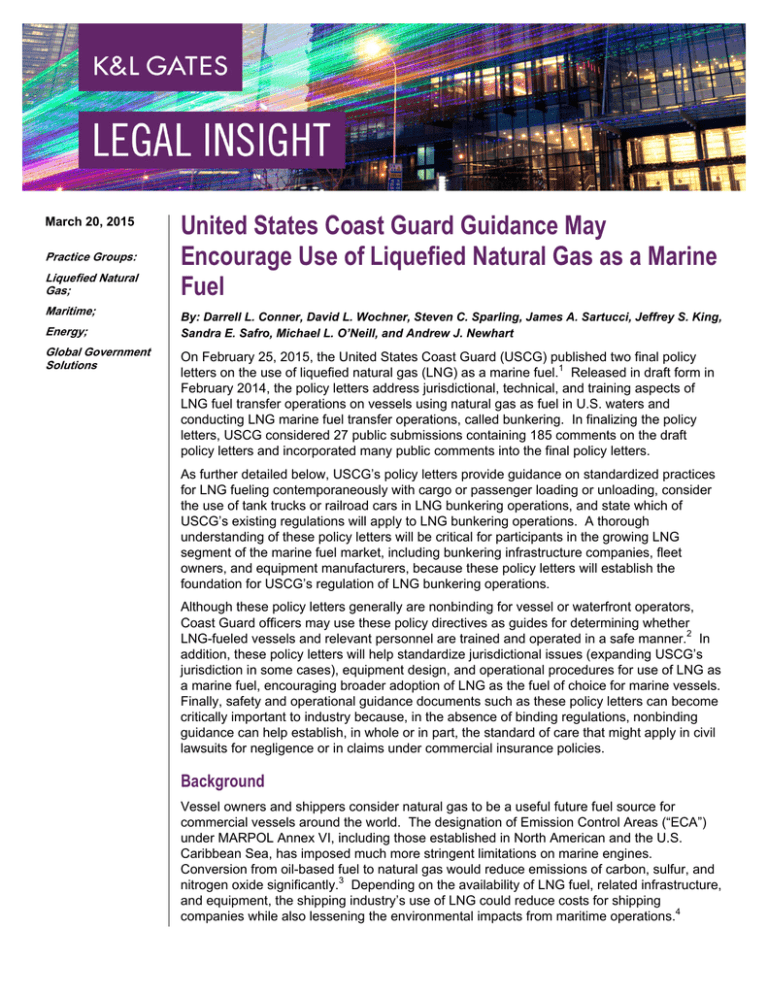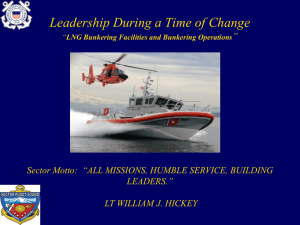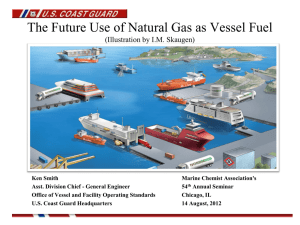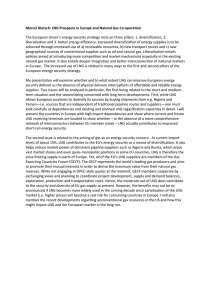
March 20, 2015
Practice Groups:
Liquefied Natural
Gas;
Maritime;
Energy;
Global Government
Solutions
United States Coast Guard Guidance May
Encourage Use of Liquefied Natural Gas as a Marine
Fuel
By: Darrell L. Conner, David L. Wochner, Steven C. Sparling, James A. Sartucci, Jeffrey S. King,
Sandra E. Safro, Michael L. O’Neill, and Andrew J. Newhart
On February 25, 2015, the United States Coast Guard (USCG) published two final policy
letters on the use of liquefied natural gas (LNG) as a marine fuel.1 Released in draft form in
February 2014, the policy letters address jurisdictional, technical, and training aspects of
LNG fuel transfer operations on vessels using natural gas as fuel in U.S. waters and
conducting LNG marine fuel transfer operations, called bunkering. In finalizing the policy
letters, USCG considered 27 public submissions containing 185 comments on the draft
policy letters and incorporated many public comments into the final policy letters.
As further detailed below, USCG’s policy letters provide guidance on standardized practices
for LNG fueling contemporaneously with cargo or passenger loading or unloading, consider
the use of tank trucks or railroad cars in LNG bunkering operations, and state which of
USCG’s existing regulations will apply to LNG bunkering operations. A thorough
understanding of these policy letters will be critical for participants in the growing LNG
segment of the marine fuel market, including bunkering infrastructure companies, fleet
owners, and equipment manufacturers, because these policy letters will establish the
foundation for USCG’s regulation of LNG bunkering operations.
Although these policy letters generally are nonbinding for vessel or waterfront operators,
Coast Guard officers may use these policy directives as guides for determining whether
LNG-fueled vessels and relevant personnel are trained and operated in a safe manner.2 In
addition, these policy letters will help standardize jurisdictional issues (expanding USCG’s
jurisdiction in some cases), equipment design, and operational procedures for use of LNG as
a marine fuel, encouraging broader adoption of LNG as the fuel of choice for marine vessels.
Finally, safety and operational guidance documents such as these policy letters can become
critically important to industry because, in the absence of binding regulations, nonbinding
guidance can help establish, in whole or in part, the standard of care that might apply in civil
lawsuits for negligence or in claims under commercial insurance policies.
Background
Vessel owners and shippers consider natural gas to be a useful future fuel source for
commercial vessels around the world. The designation of Emission Control Areas (“ECA”)
under MARPOL Annex VI, including those established in North American and the U.S.
Caribbean Sea, has imposed much more stringent limitations on marine engines.
Conversion from oil-based fuel to natural gas would reduce emissions of carbon, sulfur, and
nitrogen oxide significantly.3 Depending on the availability of LNG fuel, related infrastructure,
and equipment, the shipping industry’s use of LNG could reduce costs for shipping
companies while also lessening the environmental impacts from maritime operations.4
United States Coast Guard Guidance May Encourage Use of Liquefied Natural
Gas as a Marine Fuel
To use natural gas as a marine fuel, the natural gas will be stored on and transferred to
vessels in the form of LNG. There are regulations currently in the Code of Federal
Regulations that cover the design, equipment, operations, and training of personnel on
vessels that carry LNG as cargo and at waterfront facilities that handle LNG in bulk, but there
are no regulations for fuel transfers. Similarly, current regulations cover conventional oil fuel
transfer, but not LNG fuel transfer.5 The maritime industry is looking at a variety of ways for
supplying the LNG to the vessels, including barges, tankers, or shore-based structures such
as storage tanks, mobile tank trucks, and railcars.
International maritime organizations are developing guidelines to establish standardized
infrastructure and operational procedures to ensure that LNG marine fuel transfer and usage
operations are conducted in a safe and uniform manner in the global maritime community.
The Coast Guard has developed these policy letters to assist owners, operators, and Coast
Guard units in understanding existing U.S. regulations that apply to LNG fuel transfers and
storage facilities.6
The Policy Letters
Against this backdrop, USCG released two finalized policy letters on February 25, 2015, to
address the use of LNG as a marine fuel. A brief outline of the key provisions follows.
Guidelines for Liquefied Natural Gas Fuel Transfer Operations and Training of Personnel on
Vessels Using Natural Gas as Fuel (Policy Letter No. 01-15)
Policy Letter No. 01-15 sets forth the existing federal regulations applicable to vessels using
LNG as fuel, including operations and training requirements.7 Existing regulations require
certain cargo handling and emergency manuals,8 and the policy guidance outlines the type
of information required in these manuals, including: an explanation of hazards from LNG; a
description of LNG containment systems, other vessel systems, and emergency procedures;
and a definition of the operating envelope for which safe LNG transfer can and cannot
occur.9 Existing regulations also provide that the Captain of the Port (COTP) may require
advanced notice by facility or vessel owners for material transfer operations,10 and the
guidance asserts that this regulation covers LNG transfer operations as well as transfer of
other materials.
The policy guidance also addresses simultaneous shipboard operations, where LNG fueling
operations might occur simultaneously with other shipboard operations, such as passenger,
cargo, or ship store loading.11 Prior to conducting simultaneous operations, facility owners
should conduct formal operational risk assessments to evaluate potential risks and additional
hazards from simultaneous operations, and the COTP should use these risk assessments to
help determine whether the simultaneous operations can be completed safely.
The policy letter includes detailed guidance for the training of mariners on vessels using
gases, such as LNG, or other low flashpoint fuels.12 The guidance includes standards of
competence for basic and advanced training, and standards for documenting training
completion and certifications.
2
United States Coast Guard Guidance May Encourage Use of Liquefied Natural
Gas as a Marine Fuel
Finally, Policy Letter No. 01-15 provides additional guidance on vessel and waterfront facility
equipment, including the following:
• Bunkering systems;
• Deck lighting;
• Personnel protection;
• Portable gas detectors;
• Radio and communication equipment;
• LNG fuel transfer hoses;
• LNG bunkering manifolds;
• Spill protection;
• Emergency shutdown systems; and
• Alarms and indicators.
Guidance Related to Vessels and Waterfront Facilities Conducting Liquefied Natural Gas
(LNG) Marine Fuel Transfer (Bunkering) Operations (Policy Letter 02-15)
The Coast Guard’s Policy Letter No. 02-15 provides detailed guidance for LNG bunkering
operations from vessel to vessel or from waterfront facilities to vessels. The policy letter
states that “owners and operators of vessels and waterfront facilities conducting LNG
transfer operations as well as owners and operators of vessels using LNG as fuel should be
familiar with the contents of this policy letter,” indicating that this guidance will inform USCG’s
regulation of LNG bunkering operations going forward. The key provisions of Policy Letter
No. 02-15 are outlined below.
Policy Letter No. 02-15 notes that numerous existing regulations under 33 C.F.R. Part 127
apply to vessels and waterfront facilities handling LNG in bulk. However, the guidance
makes clear that its regulations do not apply to deepwater ports, which are offshore facilities
used to handle natural gas for transportation to or from any state.13 Enclosures 1 and 2 with
Policy Letter No. 02-15 outline the application of existing regulations to vessels and facilities
involved in LNG bunkering operations, and note the availability of alternatives to compliance
with Part 127.
Recognizing that tank trucks and railcars are not usually considered waterfront facilities
handling LNG, the policy letter determines that “any location where LNG tank trucks or
railcars are used to transfer LNG to vessels for use as a marine fuel must be viewed and
regulated as a waterfront facility handling LNG.”14 The guidance notes that tank trucks or
railcars used for LNG bunkering will be required to meet applicable state or federal design
requirements, and operators intending to use tank trucks or railcars for LNG bunkering
should provide the COTP with a detailed list of applicable requirements under the Hazardous
Materials Regulations.15
USCG’s policy letter also discusses onshore storage tanks used in LNG bunkering
operations. Because waterfront LNG facilities are often used for import or export of natural
gas, they are generally within the jurisdiction of the Federal Energy Regulatory Commission
(FERC). However, USCG notes that because storage tanks used in LNG bunkering will not
3
United States Coast Guard Guidance May Encourage Use of Liquefied Natural
Gas as a Marine Fuel
be used for LNG imports or exports, they will not be within FERC’s jurisdiction. Instead, such
storage tanks may be under the jurisdiction of other federal, state, or local authorities.16
Finally, the policy letter also considers the safety and security of LNG bunkering operations.
USCG notes that the waterway suitability assessment (WSA) process required by 33 C.F.R.
Part 127 was designed for large LNG carriers and large-scale LNG waterfront facilities, not
the smaller vessels and facilities to be used for LNG bunkering operations.17 The guidance
provides that some elements of the WSA process may not be applicable to LNG bunkering
operations, and leaves to the COTP’s discretion whether to accept an alternative safety and
security review to the WSA and other safety programs.
Implications
Even though these policy letters are ostensibly nonbinding,18 the decisions to apply USCG
regulations to tank trucks and railcars involved in LNG bunkering and other guidance to
COTPs for their reviews of LNG bunkering operations suggest that these letters will have a
significant impact on LNG fueling operations in the United States. By applying 33 C.F.R.
Part 127 to tank trucks and railcars, USCG is extending its jurisdiction to equipment and
facilities not traditionally viewed as part of waterfront facilities, and operators of tank trucks
and railcars engaged in LNG bunkering operations will need to be cognizant of the additional
requirements of Part 127.
Nonbinding guidance documents such as these also could form, in whole or in part, the basis
of standards of care in the negligence or insurance contexts. For example, in the absence of
formal regulations, courts may use guidance documents like these policy letters to form the
basis of a standard of reasonable care in civil lawsuits. Likewise, commercial insurers may
expect and require their insureds to comply with USCG’s guidance for safe operations,
including compliance with these policy letters. Therefore, owners and operators of vessels
and onshore facilities are encouraged to familiarize themselves with, and adhere to, the
content of these policy letters.
In addition to expanding jurisdictional treatment, the policy letters attempt to standardize
equipment design and operating procedures. Standardizing equipment and procedures will
encourage broader adoption of LNG as a marine fuel because standardization should lead to
lower costs for equipment and more efficient operations. As costs decline, and as Annex VI
fuel restrictions increase, adoption of LNG as a marine fuel should expand. However, as
with other types of marine activities, COTPs retain significant discretion over LNG bunkering
operations, so owners and operators of vessels should monitor development of standards
and practices for LNG bunkering in relevant local operating environments.
4
United States Coast Guard Guidance May Encourage Use of Liquefied Natural
Gas as a Marine Fuel
Authors:
Darrell L. Conner
Government Affairs Counselor
Jeffrey S. King
Partner
darrell.conner@klgates.com
+1.202.661.6220
jeffrey.king@klgates.com
+1.617.261.3179
David L. Wochner
Partner
Sandra E. Safro
Associate
david.wochner@klgates.com
+1.202.778.9014
sandra.safro@klgates.com
+1.202.778.9178
Steven C. Sparling
Partner
Michael L. O’Neill
Associate
steven.sparling@klgates.com
+1.202.778.9085 (Washington, D.C.)
+1.713.815.7300 (Houston)
mike.oneill@klgates.com
+1.202.778.9037
James A. Sartucci
Government Affairs Counselor
jim.sartucci@klgates.com
+1.202.778.9374
Andrew J. Newhart
Government Affairs Specialist
andrew.newhart@klgates.com
+1.202.778.9384
Anchorage Austin Beijing Berlin Boston Brisbane Brussels Charleston Charlotte Chicago Dallas Doha Dubai Fort Worth Frankfurt
Harrisburg Hong Kong Houston London Los Angeles Melbourne Miami Milan Moscow Newark New York Orange County Palo Alto Paris
Perth Pittsburgh Portland Raleigh Research Triangle Park San Francisco São Paulo Seattle Seoul Shanghai Singapore Spokane
Sydney Taipei Tokyo Warsaw Washington, D.C. Wilmington
K&L Gates comprises more than 2,000 lawyers globally who practice in fully integrated offices located on five
continents. The firm represents leading multinational corporations, growth and middle-market companies, capital
markets participants and entrepreneurs in every major industry group as well as public sector entities, educational
institutions, philanthropic organizations and individuals. For more information about K&L Gates or its locations,
practices and registrations, visit www.klgates.com.
This publication is for informational purposes and does not contain or convey legal advice. The information herein should not be used or relied upon in
regard to any particular facts or circumstances without first consulting a lawyer.
© 2015 K&L Gates LLP. All Rights Reserved.
1
Policy Letters: Guidance for the Use of Liquefied Natural Gas as a Marine Fuel, 80 Fed. Reg.
10,131 (Feb. 25, 2015).
2
In the Policy Letters, the USCG expressly refused to consider compressed natural gas (CNG)fueled vessels, preferring instead to adopt a fuel-by-fuel approach to its review of the adequacy of
existing regulations.
3
U.S. COAST GUARD, CG-OES POLICY LETTER NO. 01-15, GUIDELINES FOR LIQUEFIED NATURAL GAS
FUEL TRANSFER OPERATIONS AND TRAINING OF PERSONNEL ON VESSELS USING NATURAL GAS AS
FUEL at 1 (2015), available at
http://www.regulations.gov/contentStreamer?objectId=0900006481a0fd51&disposition=attachme
nt&contentType=pdf (last visited Feb. 27, 2015) (hereinafter “Policy Letter No. 01-15”).
4
Other options for complying with Annex VI exist, such as switching to the use of ultra-low sulfur
fuel (i.e., less than 0.1% sulfur) or using exhaust gas scrubbers while operating in an ECA. Each
5
United States Coast Guard Guidance May Encourage Use of Liquefied Natural
Gas as a Marine Fuel
of those options has its own costs and operational difficulties, such as damage to equipment,
operational failures, the need for sources of compliant fuel (which is costly), and the need for
methods to dispose of scrubber process fluids/sludge. Moreover, each of these options still
leaves vessels open to the possibility of noncompliance and potential costly civil and criminal
proceedings against the vessel and its interests. Conversely, the use of LNG would appear to
remove many of those risks. Moreover, the current schedule will require that, as of 2020, ships
operating anywhere globally (i.e., outside of ECAs) will need to burn a low sulfur fuel (i.e., less
than 0.5%, whereas the current limit is 3.5%). Thus, even for ships operating outside of ECAs,
the cost of fuel will likely increase as these regulations become effective.
5
See 33 C.F.R. Parts 127, 155, and 156. See also 46 C.F.R. Parts 10–15, 30–39, and 154.
6
U.S. COAST GUARD, CG-OES POLICY LETTER NO. 02-15, GUIDANCE RELATED TO VESSELS AND
WATERFRONT FACILITIES CONDUCTING LIQUEFIED NATURAL GAS (LNG) MARINE FUEL TRANSFER
(BUNKERING) OPERATIONS at 2 (2015), available at
http://www.regulations.gov/contentStreamer?objectId=0900006481a0fd52&disposition=attachme
nt&contentType=pdf (last visited Feb. 27, 2015) (hereinafter “Policy Letter No. 02-15”).
7
Policy Letter No. 01-15 excludes vessels regulated as LNG carriers that use boil-off gas as fuel.
8
See 33 C.F.R. § 127.305–309 and 46 C.F.R. § 154.1810.
9
Policy Letter No. 01-15 at 2.
10
33 C.F.R. § 156.118.
11
Policy Letter No. 01-15 at 6.
12
Policy Letter No. 01-15 at Enclosure 3.
13
Policy Letter No. 02-15 at 3.
14
Policy Letter No. 02-15, Enclosure 1 at 2.
15
Policy Letter No. 02-15, Enclosure 1 at 2.
16
Policy Letter No. 02-15, Enclosure 1 at 3.
17
Policy Letter No. 02-15, Enclosure 1 at 5–6.
18
The USCG emphasized in its February 25 Notice that it received several comments on the draft
letters from interested participants that it is not able to incorporate at this time because to do so
the agency would have to go through a formal rulemaking process.
6





